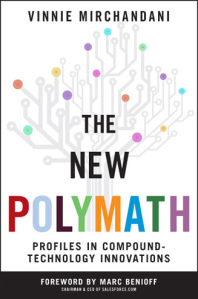Archive of: Innovation
Blog Post

I had the pleasure of interviewing Apple co-founder Steve Wozniak onstage at the recent FISConnect conference. He told the audience of 1300 financial services leaders that every company today needs a chief disruption officer -- someone with a personal passion for a new way of doing things -- and that person should not report to the CEO.
Blog Post

I have to admit it — I'm baffled. In all the research I've done in the past year, business leaders again and again say they believe the CIO is the right person to lead digital innovation. And yet, again and again, there's a gap between where everyone — CIOs and their business partners included — think the CIO should be and where they actually are. CIOs just can't seem to break out of the technology service provider role.
In the Harvard Business Review Analytic Services study, "Business Transformation and the CIO Role," 94% of respondents said CIOs would add the most value to the business by either leading business technology transformation or, even better, leading IT-driven business innovation and strategy. Only 6% voted for the CIO to focus on running the IT function to support business operations. And yet the vast majority — 70% — said that's exactly where the CIO spends his or her time.
I've also had a number of conversations lately with strategic CIOs who view their role as helping their business leverage information — they frame the digital opportunity in that context. Sure, they need technology to do that, but that's not where the value lies or how they define their role.
Blog Post

Back in the 1990s and into the early part of the 2000s, we ran an awards program at CIO magazine called the Enterprise Value Awards. This was a unique and truly outstanding awards program that scrutinized the work being done by CIOs and their business partners — and the results being delivered — through the use of information technology. Every nomination had to have a CIO and a business leader as joint sponsors. They had to prove claimed financial value by having the company's CFO sign off on the numbers. Every finalist received a site visit from an experienced reviewer who met in person with company leaders and users of the system to vet the claims being made. These review board members then presented their findings to a blue-ribbon panel of CIOs at a day-long meeting in Boston. The winners were recognized at an annual Enterprise Value Retreat.
Blog Post

Creating the conditions for and harnessing innovation isn't easy, especially for large organizations. Innovation Accelerators — companies that are committed to innovation across the enterprise — take a managed, structured approach. That may seem contradictory — after all, isn't innovation supposed to be creative and spontaneous? Creative, yes, but if you rely on spontaneous combustion to light your innovation process, your results will be uneven at best.
Blog Post

One of the most interesting research projects I've worked on in the past year was an HBR Analytics Services study sponsored by Red Hat as part of their Enterprisers Project. In it, we divided the universe based on respondents' posture toward IT-driven business innovation — for simplicity's sake, let's call it digital innovation. There were three categories:
Innovation Accelerators: These respondents said that digital innovation is a consciously pursued strategy throughout the organization — it's in their company's DNA.
Ad Hoc Innovators: These companies have pockets of digital innovation, but it is not pervasive or replicated across the whole company.
Low Prioritizers: At these firms, digital innovation is not a priority; they focus elsewhere.
Blog Post

In a digital age, business survival depends on responsive IT. That is one of three key findings from a recent global survey of 750 business and technology leaders that I led for HBR Analytic Services ("The Leadership Edge in Digital Transformation"). Almost half of respondents (47%) said their organization had missed opportunities because IT was too slow to respond. While it's reasonable to expect some misses, companies with slow-to-respond IT departments were much more likely to say this at 64% than were respondents from companies with responsive IT (only 27% said they'd missed opportunities).
Companies with highly responsive IT (let's just call them the "Leaders" for brevity's sake) have gone faster and farther in making the transition to digital business than their competitors. This proved to be the case across many dimensions, starting with the ways in which they engage with customers: 68% of the Leaders said their customer engagement had been transformed by their use of new technologies compared with only 33% of Laggards. The delta was even greater when it came to business model transformation, with 62% of Leaders transformed compared with only 24% of Laggards. This translates directly to competitive advantage.
Blog Post

Business leaders anticipate dramatic change in all aspects of their operations over the next three years, according to recent research from Harvard Business Review Analytic Services (you can download a copy of the report I authored, Business Transformation and the CIO Role, at the HBR website). Some companies are accelerating this change by committing to IT-enabled business innovation as a core strategy. To understand just how massive the changes will be, consider this: 70 percent of these “innovation accelerators" (about a third of respondents) expect the ways in which they engage with customers to be transformed in three years, rating it eight or higher on a 10-point change scale. That's right: 70 percent. Transformed. Sixty-four percent anticipate that same degree of change in their products and services, their business models and the ways employees work.
Blog Post
Here's a Skype interview I did with McGraw Milhaven on KTRS in St. Louis before speaking at the Gateway to Innovation Conference.
Blog Post

The New Polymath, by Vinnie Mirchandani, is an ambitious, wide-ranging and celebratory exploration of technology innovation in the 21st century. The book epitomizes the title (a polymath is someone who excels in many disciplines) in taking on the distinct, though certainly overlapping, disciplines of infotech, cleantech and healthtech – and all the various technologies and practices that support them. It evokes the spirit of polymaths throughout history (Sir Isaac Newton, Benjamin Franklin, Hypatia of Alexandria, and the ultimate polymath, Leonardo da Vinci) and seeks their equivalents in our own times in both individuals (Bill Joy, Nathan Myhrvold) and organizations. Most provocative, it sets up a parallel between our age and the 14th century, when the Late Middle Ages, or Dark Ages, gave way to the Renaissance, or rebirth. Mirchandani is hopeful that we are entering another Renaissance.




